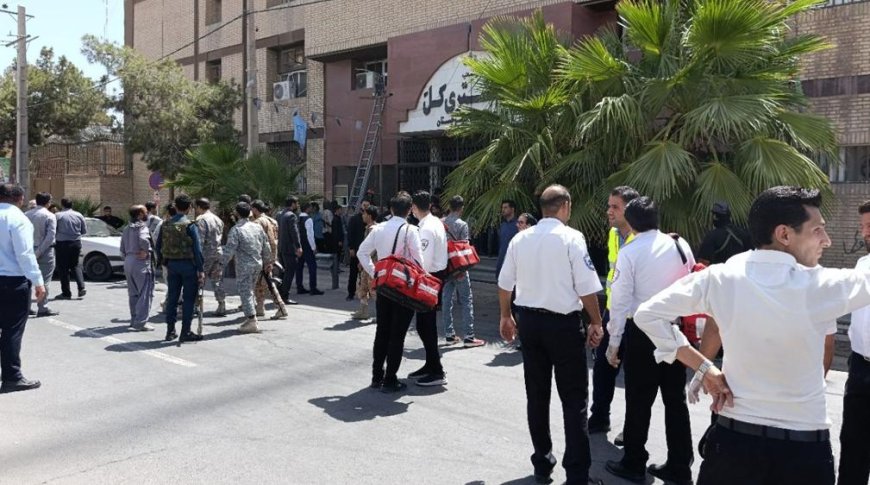Courthouse Siege in Iran’s Southeast: At Least Six Dead, Twenty Injured in Militant Assault
Gunmen identified with Jaish al‑Adl attacked a courthouse in Zahedan, killing six—including a child—and injuring twenty in southeastern Iran’s Sistan and Baluchestan. The attack marks a serious escalation in regional instability.

In one of the deadliest security incidents in recent years, unknown gunmen stormed a courthouse in Zahedan, the capital of Iran’s southeastern Sistan and Baluchestan province, killing six people—including a mother and child—and wounding around twenty others. The assault marked a serious escalation in regional violence, with analysts pointing to growing instability along Iran’s porous eastern borders.
Attack Overview: Methodical and Brutal
The assault began within the courthouse premises, where attackers reportedly fired automatic weapons and launched grenades. Iranian state-affiliated outlets confirmed the use of explosive devices and said the attackers attempted entry disguised as visitors. Once inside, gunfire erupted in court offices before they initiated a prolonged three-hour clash with security forces.
Eyewitnesses described chaos and panic as civilians and court staff tried to flee. A local human rights group reported that several judiciary personnel and law enforcement officers were among the wounded. At least five civilians—among them a mother and toddler—were confirmed dead, with some sources citing a ninth fatality including the attackers themselves.
Reuters+5The Guardian+5The National+5
Perpetrator Claim: Jaish al-Adl’s Statement
The Sunni separatist group Jaish al-Adl, which operates primarily in Iran’s Baloch-majority regions, claimed responsibility through its Telegram channel. The group asserted that the attack targeted judges and court staff responsible for directing death sentences and demolitions against Baloch citizens. They issued a chilling warning: Zahedan would "no longer be a safe place" for any judiciary official.
Authorities confirmed that three assailants were killed during the security response. Officials noted that the attackers were allegedly wearing undeployed explosive vests, raising fear that the assault may have involved coordinated suicide tactics.
AP News+9The Guardian+9Reuters+9
Casualty Profile and Damage Assessment
Among the deceased were at least one child and a middle‑aged woman; authorities have withheld full identities pending next‑of‑kin notification. The majority of the twenty injured were civilians, including court staff, visitors, and passersby. Some suffered critical injuries, including gunshot wounds and shrapnel damage, while local hospitals in Zahedan declared emergency protocols to expedite life-saving care.
AP NewsReutersAl Jazeera
Beyond the human toll, the courthouse sustained significant structural damage — shattered windows, large blast gullies in walls, and burned interiors visible in photographs circulated by regional media.
Regional Context: A Hotbed of Insurgency
Sistan and Baluchestan is among Iran’s most neglected provinces—underdeveloped, economically marginalized, and home to a largely Sunni Baloch minority. Persistent tension with Iran's Shia-majority government has fueled decades of conflict. Jaish al-Adl, forged around 2012, has carried out multiple deadly attacks, including raids on security checkpoints and military convoys.
Notably, in late 2024, militants ambushed a police convoy in the region, killing at least ten officers. Earlier, coordinated assaults on multiple security installations in Chabahar and Rask left many dead and signaled the group’s growing tactical capability.
AP News+15Wikipedia+15The National+15CBS News+4Wikipedia+4Deutsche Welle+4
Government Response and Security Implications
Iranian officials responded swiftly. Security forces surrounded the courthouse, contained the assailants, and secured the broader area within hours. Iran’s judiciary publicly designated the incident as a “terrorist attack” and pledged a full investigation.
Regional law enforcement authorities have since tightened security in Zahedan, increasing checkpoints and ordering expedited court operations. National leadership, including the judiciary and the Revolutionary Guard command, is under pressure to respond decisively. There is growing scrutiny of how militants could approach such a sensitive site undetected.
ReutersRadioFreeEurope/RadioLibertyCBS News
Broader Impact: Escalating Discontent and Institutional Threat
This assault on a central judiciary institution represents a marked escalation. By targeting a courthouse, militants aimed not only at inflicting casualties but also at sending a symbolic message to Iran’s legal system. Human rights observers warn that such attacks may embolden other groups and undermine public trust in state protection.
The attack also intensifies concerns about Iran’s border security and the efficacy of internal surveillance mechanisms. Critics point to ongoing neglect of infrastructure and community outreach in Sistan and Baluchestan, and argue the government's response must include political as well as security measures.
Community Response and Human Rights Watch
Local Baloch community leaders condemned the violence but reiterated longstanding grievances over economic exclusion and heavy-handed judicial practices. Human rights NGOs described the attack as the deadliest of its kind in years—and an example of how judicial targets are increasingly viewed as symbols of state oppression by armed groups.
These groups have also highlighted Iran’s recent spike in court-ordered executions, particularly in Zahedan Central Prison, where Baloch inmates have reportedly faced disproportionate prosecution. Jaish al-Adl itself has cited judicial sentences and prison executions among its motivations.
ایران اینترنشنال | Iran International
What Happens Next: Key Questions
-
Will security strategy shift in Zahedan? Authorities must decide whether to deploy reinforced patrols, install checkpoints around judicial complexes, or restrict courthouse entry protocols.
-
Can the justice system be insulated? There are calls for improved intelligence sharing and protective protocols for judiciary workers, who may now be considered high-risk targets.
-
Will broader socio-economic grievances be addressed? Analysts argue that robust military responses alone cannot stabilize the region—infrastructure investment and local inclusion policies may be necessary.
-
Could this trigger further attacks? If the group sees symbolic success, copycat incidents targeting other government institutions may increase across the southeast region.
Concluding Note: A Grave Symbol of Judicial Vulnerability
The Zahedan courthouse attack marks a pivotal moment in Iran’s internal security challenges. Six lives lost—two civilians and four institutionally connected staff—and dozens injured have underscored growing militancy in one of the country’s most troubled provinces.
Beyond tragedy, the attack lays bare deep structural vulnerabilities: a remote border region plagued by insurgency, limited development, and deep-seated political grievances. As authorities work to restore order, the coming days may determine whether Zahedan becomes a turning point in Iran’s strategy—or a continuing frontline in an unresolved conflict.




















































